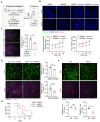Platelet Glycoprotein Ibα Cytoplasmic Tail Exacerbates Thrombosis During Bacterial Sepsis
- PMID: 39519103
- PMCID: PMC11546206
- DOI: 10.3390/ijms252111548
Platelet Glycoprotein Ibα Cytoplasmic Tail Exacerbates Thrombosis During Bacterial Sepsis
Abstract
Septic patients, coupling severe disseminated intravascular coagulation (DIC) and thrombocytopenia, have poor prognoses and higher mortality. The platelet glycoprotein Ibα (GPIbα) is involved in thrombosis, hemostasis, and inflammation response. However, it remains unclear whether the GPIbα cytoplasmic tail regulates sepsis-mediated platelet activation and inflammation, especially in Staphylococcus aureus (S. aureus) and Escherichia coli (E. coli) infections. Using a mouse model of S. aureus-induced bacteremia, we found that both 10 amino acids of GPIbα C-terminal sequence deficiency and pharmacologic inhibition of protein kinase C (PKC) alleviated pathogenesis by diminishing platelet activation and aggregate formation. Furthermore, the GPIbα cytoplasmic tail promoted the phagocytosis of platelets by Kupffer cells in vivo. The genetically deficient GPIbα cytoplasmic tail also downregulated inflammatory cytokines and reduced liver damage, ultimately improving the survival rate of the septic mice. Our results illustrate that the platelet GPIbα cytoplasmic domain exacerbates excessive platelet activation and inflammation associated with sepsis through a PKC-dependent pathway. Thus, our findings provide insights for the development of effective therapeutic strategies using PKC inhibitor treatment against bacterial infection.
Keywords: GPIbα; PKC; bacterial infection; inflammation; platelet activation.
Conflict of interest statement
The authors declare no competing interests.
Figures







Similar articles
-
The role of protein kinase C and the glycoprotein Ibα cytoplasmic tail in anti-glycoprotein Ibα antibody-induced platelet apoptosis and thrombocytopenia.Thromb Res. 2024 Dec;244:109210. doi: 10.1016/j.thromres.2024.109210. Epub 2024 Nov 7. Thromb Res. 2024. PMID: 39541612
-
Essential role of glycoprotein Ibα in platelet activation.Blood Adv. 2024 Jul 9;8(13):3388-3401. doi: 10.1182/bloodadvances.2023012308. Blood Adv. 2024. PMID: 38701351 Free PMC article.
-
Filamin A binding to the cytoplasmic tail of glycoprotein Ibalpha regulates von Willebrand factor-induced platelet activation.Blood. 2003 Sep 15;102(6):2122-9. doi: 10.1182/blood-2002-12-3805. Epub 2003 Jun 5. Blood. 2003. PMID: 12791664
-
Platelet physiology and thrombosis.Thromb Res. 2004;114(5-6):447-53. doi: 10.1016/j.thromres.2004.07.020. Thromb Res. 2004. PMID: 15507277 Review.
-
Mechanisms of platelet activation by thrombin: a short history.Thromb Res. 2012 Mar;129(3):250-6. doi: 10.1016/j.thromres.2011.11.001. Epub 2011 Dec 2. Thromb Res. 2012. PMID: 22137742 Review.
References
-
- Donnelly J.P., Safford M.M., Shapiro N.I., Baddley J.W., Wang H.E. Application of the Third International Consensus Definitions for Sepsis (Sepsis-3) Classification: A retrospective population-based cohort study. Lancet Infect. Dis. 2017;17:661–670. doi: 10.1016/S1473-3099(17)30117-2. - DOI - PMC - PubMed
MeSH terms
Substances
Grants and funding
LinkOut - more resources
Full Text Sources
Medical

